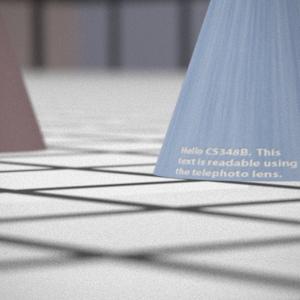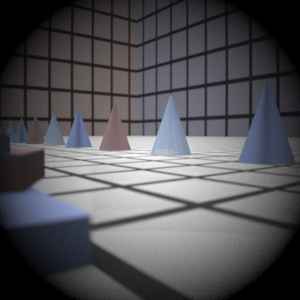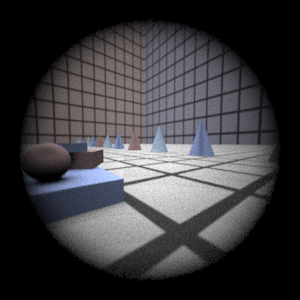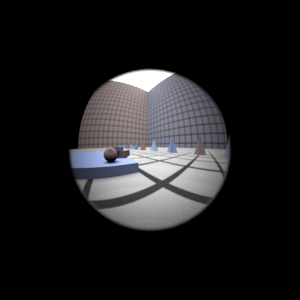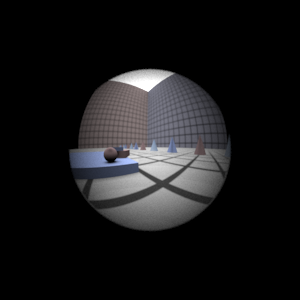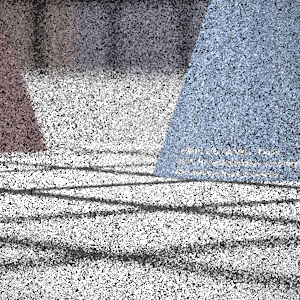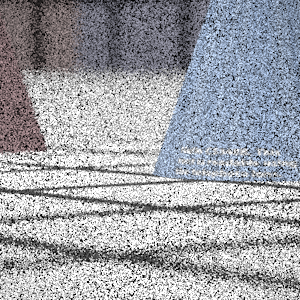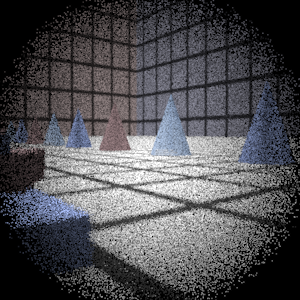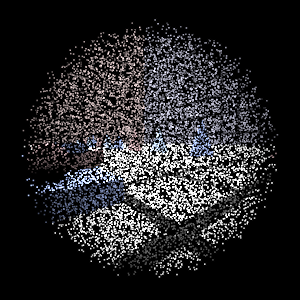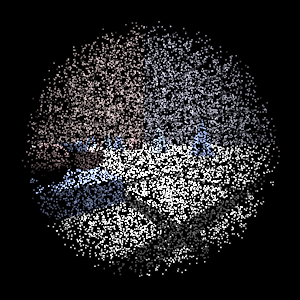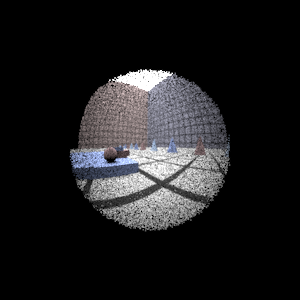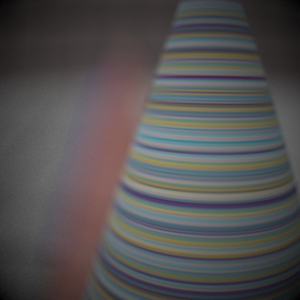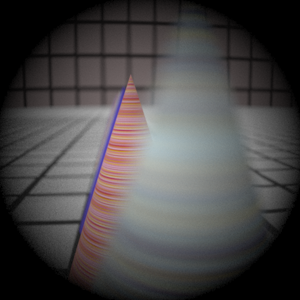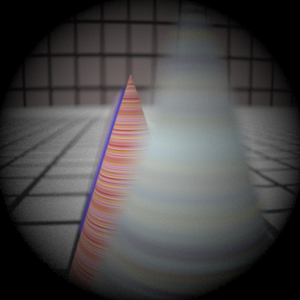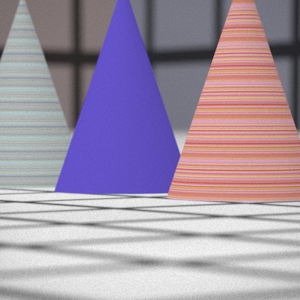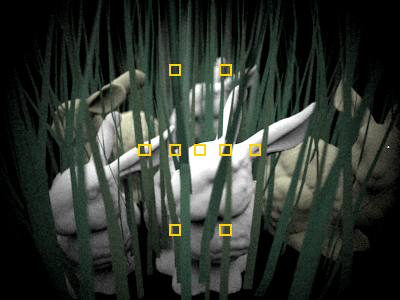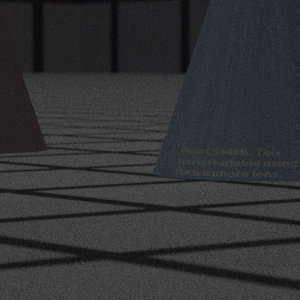Assignment 3 Camera Simulation
Sean Rosenbaum
Date submitted: 5 May 2006
Code emailed: 5 May 2006
Compound Lens Simulator
Description of implementation approach and comments
First I transform the raster position of samples on the image plane to camera space, I begin by computing several transformations composing it. Many of the transformations are nearly identical to those presented in the text for orthogonal and perspective cameras. A couple things must be taken into account when computing them. First, the film plane is in the negative z-direction at a distance equal to the film distance plus the sum of the thickness of the lens interfaces. Second, the film diagonal and the horizontal and vertical resolution are given, rather than the extent of the screen. Fortunately, computing the screen extent from this is a trivial matter. Otherwise, the pbrt code is reused here.
Next, the camera description is read in and each interface is stored in order. I keep track of the displacement of each interface from the z-axis and store a flag designating the intersection type (partial sphere or disk) determined by the radius of curvature passed in. If the interface is curved, I identify the center position of the sphere representing it by adjusting the interface's position along the z-axis by its radius, with direction dependent on whether it is concave or convex. Also, again if it's a sphere, I compute its maximum and minimum z-value using its aperture and curvature (and some basic math!). In order to trace rays through the system, I use pbrt's sphere and disk intersection code. A few lines used for evaluating the differential geometry were removed from the sphere code to make tracing a little speedier. As a minor optimization, I also save the ratios of the indices of refraction I use when tracing the rays.
At this point the camera's been constructed and rays are generated. Each sample position on the image plane is transformed to camera space and the lens sample (from ConcentricSampleDisk()) is scaled to lie on the disk with diameter equal to the aperture of the back lens, at the back lens location. These two samples define the ray I pass through the system. The ray is tested for intersection with each interface and the aperture stop, starting with the back lens. I ensure the ray hits each interface, but not the aperture stop, as it makes its way through. At each interface intersection, I replace the ray with one originating at the surface having the direction of the refracted vector given by Snell's law. When computing the refraction, I check for total internal reflection.
Only a fraction of the rays actually make it through the system and out into the world. Those that do are weighted by the product of the area of the disk initially fired at and the fourth power of cos(theta), where theta is the angle the initial ray makes with the normal of the image plane, all divided by the square of the film distance. Since all directions are normalized, cos(theta) obviously simplifies to the z component of the initial direction. Rays not making it through the system are given zero weight so they will be ignored. Finally, each ray's extents, mint and maxt, are set and the ray is transformed from camera space to world space.
My simulation's renders are nearly identical to the reference ones (actually, mine are probably better ![]() ).
).
Debugging
Once all the code for tracing rays through the lens was in place, I found my implementation too bugged to produce meaningful results. While I managed to track down several bugs using the debugger, I was still getting junk. I verified my transformations were working correctly by substituting pbrt's perspective camera into my code. This confirmed that my tracing was to blame. After several hours of frustration, I decided to produce a visualization as suggested in the assignment description. The visualization shows where each lens is located, the path of rays through the system, the normals of the elements they hit, and their refraction direction. For ease of implementation, the visualization is in 2D, with the top display showing the lens from the (-z)-x plane and the bottom the (-z)-y plane. This visualization helped immensely. Shortly after it was in operation I managed to hunt down the remaining bugs. The visualization code is embedded in realistic.cpp. To enable it, you must recompile with #define CAM_VIZ 1 and have SDL installed.
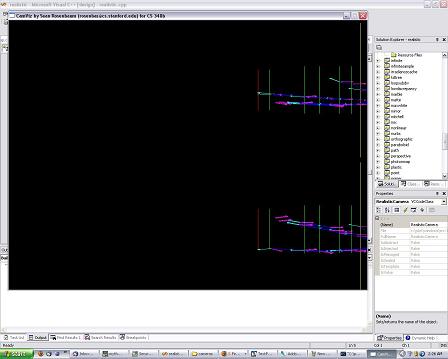
Each interface comes into view once a ray tests for intersection against it. Only a single vertical line is drawn for each interface, which is located where the element has the disk of max aperture. The intersection normal and refraction direction emanate from the actual points on the surfaces they intersect. The entire process is animated so that it's easy to follow along one step at a time.
Final Images Rendered with 512 samples per pixel
|
My Implementation |
Reference |
Telephoto |
|
|
Double Gausss |
|
|
Wide Angle |
|
|
Fisheye |
|
|
Final Images Rendered with 4 samples per pixel
|
My Implementation |
Reference |
Telephoto |
|
|
Double Gausss |
|
|
Wide Angle |
|
|
Fisheye |
|
|
Experiment with Exposure
Image with aperture full open |
Image with half radius aperture |
|
|
Observation and Explanation
The f-number is proportional to the ratio of the focal length and the aperture. Therefore after halving the aperture so fewer rays pass through, I expected to see a two-stop reduction in the exposure, which corresponds to a quarter of the original exposure. It's evident the exposure for the simulation did indeed decrease as expected. At the bottom of this page I have an example demonstrating that exposure is not the only thing that changes.
Autofocus Simulation
Description of implementation approach and comments
My algorithm relies heavily on the Sum-Modified-Laplacian (SML) to approximate the focus for several film distances. The SML is computed for the auto focus zone, using the entire zone as the window and the intensity of the RGB values (i.e. max(R,G,B)) given by the camera sensor, at a given film distance. In order to find the optimal film distance, I treated this as a one-dimensional optimization problem over a unimodal function. To keep my autofocus flexible and entirely automated, I made my search range very large, from 0 to 220mm, regardless of the camera used. Obviously effectively searching over a range this large requires a fast and robust search. I first attempted to do a bisection-like search over the search range. This entailed taking two sample film distances near the center of the interval, computing the SML for each, and then continuing on to the interval on the side of the sample with the greater focus. Technically, the subinterval between the two samples is also included since the maximum may reside within it. After this was fully functional, I was disappointed in how slow it went because the focus calculations are quite expensive, specifically because I ramped up the number of samples to virtually eliminate noise. After perusing some literature on 1D optimization, I found that I could get by doing only one SML for each iteration, rather than two, by doing a golden section search. This algorithm is similar to the previous one. The general idea is to pick a sample position in the interval that can be reused in subsequent iterations. However, it is subject to the constraint that during each iteration, the current pair of points have the same relative positions in their interval as the previous points had. This ensures we continue to shrink the interval by a constant fraction at each iteration. This cut the autofocus time roughly in half.
Unfortunately, I ran into trouble doing these types of searches. The main problem was the SML was subject to error given that it is only an approximation. Consequently, my search would sometimes skip over a subinterval containing the optimal distance. My solution was to subdivide the search-range into several intervals, run the golden-section search on each one, and take the best film distance. The intervals vary in size. They gradually get larger as the distance from the back lens increases. This technique made my autofocus much more robust, though a bit slower. It can be made nearly as fast as a single golden-section search by immediately halting the computation for some of the intervals once it's apparent the optimal distance lies outside it. For instance, if a reasonably good focus is found in one interval, there's probably no need to search other far off intervals. Also, if the focus seems extremely bad when an interval is started, there's probably no need to continue searching it. I took advantage of this by immediately halting computation for any intervals encountering several consecutive SML results below some fraction of the current best from prior intervals, or below a predefined threshold. This halting behavior makes the algorithm even more effective at searching large intervals. The search range can be made much larger without a significant impact on performance, though I didn't see the point of making it even larger since none of these images even got remotely close to the upper end of it.
I handle several autofocus(AF) zones by replacing the SML above with a sum of SMLs, each term weighted by the area of its zone. This simply attempts to optimize the focus over all the zones. The bunny scene at the bottom of the page demonstrates that in practice this does quite well.
Future Work
![]() Successive parabolic interpolation may be more efficient than golden-section search given its faster convergence rate. This technique works by sampling several distances, forming a parabola over the results, computing the minimum of this parabola, and successively refining it.
Successive parabolic interpolation may be more efficient than golden-section search given its faster convergence rate. This technique works by sampling several distances, forming a parabola over the results, computing the minimum of this parabola, and successively refining it.
![]() SML has several parameters, including a step size for computing MLs and a minimum threshold for summing them. I set these to one and zero, respectively. I suppose tweaking them some more may lead to even better results.
SML has several parameters, including a step size for computing MLs and a minimum threshold for summing them. I set these to one and zero, respectively. I suppose tweaking them some more may lead to even better results.
![]() As stated earlier, I used a lot of samples for rendering the AF zones to get rid of noise over the entire search range. This is one reason why my images are in such great focus despite the large search range. A potentially better approach would be to render them with fewer samples and then do some image processing on the noisy ones. Doing so may give a huge boost to performance, while not significantly impacting the autofocus quality.
As stated earlier, I used a lot of samples for rendering the AF zones to get rid of noise over the entire search range. This is one reason why my images are in such great focus despite the large search range. A potentially better approach would be to render them with fewer samples and then do some image processing on the noisy ones. Doing so may give a huge boost to performance, while not significantly impacting the autofocus quality.
References
Shree K. Nayar. Shape From Focus System. IEEE Conference on Computer Vision and Pattern Recognition (CVPR), pp.302-308, Jun, 1992.
Michael T. Heath. Scientific Computing, An Introductory Survey - 2nd Ed. McGraw-Hill, 2002.
Final Images Rendered with 512 samples per pixel
|
Adjusted film distance |
My Implementation |
Reference |
Double Gausss 1 |
62.1 mm |
|
|
Double Gausss 2 |
39.8 mm |
|
|
Telephoto |
117.1 mm |
|
|
Extras
Mutizone AF
Adjusted film distance |
My Implementation |
Reference |
39.9mm |
|
|
Stop Down the Telephoto Lens
|
4-Stop |
Brightness Increased 4-Stops in Photoshop |
Original |
Telephoto |
|
|
|
In addition to the change in exposure and noise, the depth of field shifted. This is evident when comparing the two images on the right. These are all based on my implementation.

